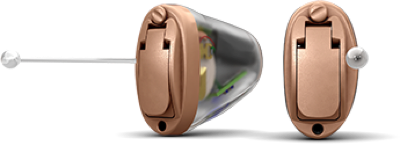Invisible-in-Canal: IIC
Invisible in Canal or IIC hearing aids are among the most popular hearing aid products on the market, offering better aesthetics and sound.

DEVICE APPEARANCE
How the IIC Hearing Aid Looks and Feels
The invisible-in-canal (IIC) hearing aid style is one of the smallest hearing devices available. The IIC is similar to the CIC where the body of the hearing aid fits entirely inside your ear canal. The difference is that the IIC is fit even further down the ear canal. The only visible part of this hearing aid style is the tiny wire that protrudes just outside the ear canal used for inserting and removing the device.


AUDIO NOTES
IIC Hearing Aids Feature a Natural Sound Profile
The IIC hearing aid produces a very natural sound profile, using the advantage of the resonances of the ear profile to conduct its natural function. This same placement also eliminates wind noise distractions and helps to detect where sound is coming from because the sound funnels through the ear canal.
Try Our Online
Hearing Test
Concerned about your hearing? Try our free no
obligation hearing screening test. This interactive test will
help you determine whether a professional consultation
would benefit you.

CUTTING-EDGE HEARING AIDS
Which Hearing Device Is Right for You?
BTE: Behind the Ear
Learn More
CIC: Completely in
Canal
Learn More
Extended Wear
Learn More
IIC: Invisible in Canal
Learn More
Mini-Canal
Learn More
ITC: In the Canal
Learn More
RIC: Receiver in Canal
Learn More
PROS AND CONS
Determining Whether IIC Hearing Aids Are Right for You
Similar to the CIC, the IIC cannot house a large amplifier to provide lots of power, making the IIC best suited to those with a mild to moderate degree of hearing loss. The small size and placement in the canal limits any on-device controls or remote access capabilities. The tiny wire or “fishing line” wire used to assist in removing and inserting the device demands good manual dexterity of the wearer. The small batteries also have a short life span so be prepared to change them often.
This style of hearing aid is also susceptible to damage from moisture and earwax – a regimented cleaning and maintenance routine will keep these performing at their best. The device is custom fit, comfortable and even reported to not be felt by the wearer. However, not all ear shapes can accommodate this style. Your hearing health professional will be able to advise if you are a good candidate during a consultation.


HEARING AID TECHNOLOGY
Options to Consider When Selecting a Hearing Aid
IIC hearing aids are just as they are titled: nearly invisible in the ear canal. They are very small and sit very deeply in the ear, and have a small pull-out string to remove them from the ear. This style is fit for people with mild to moderate hearing loss. Because of their small size, they don’t usually come with any manual controls such as a program button, but for those large enough for a program button, there is no binaural communication meaning each hearing aid would need to be adjusted separately.
ANSWERS ABOUT HEARING AIDS AND MORE
Frequently Asked Questions
An invisible in canal hearing aid should sit deeper in the ear canal than an in the canal or completely in canal hearing aid. The device is one of the smallest types of hearing aid on the market and is designed to fit snuggly further into the ear canal.
Because of the compact design, and location in the ear where the device sits, an invisible in canal hearing aid will not have any manual volume controls. Volume on these hearing devices is either controlled through a remote, or through an app on a smartphone. A select few invisible in canal devices come with Bluetooth connectivity, allowing for another method to control volume.
To clean your invisible in canal hearing aid, you will first want to wipe the surface of the device with a cleaning solution. Use a cleaning brush that comes with the IIC device to clean out any dirt or earwax that has collected in the sound outlet and vent holes. Finally, the device should be left out of your ear for a while (at night while sleeping works best) so any moisture in or on the device can dry out.
Similarly to a completely in canal hearing aid, an invisible in canal device is very small and discreet. Because the microphone on the device sits within the ear canal, these devices are less likely to pick up wind noise than other devices on the market and they provide a more natural sound experience. Finally, an invisible in canal hearing aid is custom fitted for the patient’s ears, making this style of hearing aid one of the most comfortable to wear.
Invisible in canal hearing devices are best used by people with mild to moderate hearing loss. People who are self conscious about wearing a hearing aid will be able to wear this type of device confidently thanks to its discreet design. People who live an active lifestyle will find the comfort of these devices while they are engaged in activity to be much better than any other type of hearing device on the market. Keep in mind that not everyone is a suitable candidate for an invisible in canal device as not all ear canal shapes can fit this type of hearing aid. Our clinic staff will assess your hearing loss and ear canal shape to determine if this type of device is right for you.
We would love to
hear from you!
assessment or hearing devices the professionals at NexGen Hearing
have the answers. Send us your contact information and we’ll be in
touch. Remember, there’s never any obligation and you’ll never be
pressured to make a purchase! We’re here to help!
Head Office
201 – 4500 West Saanich Rd.
Victoria, British Columbia
Canada, V8Z 3G2